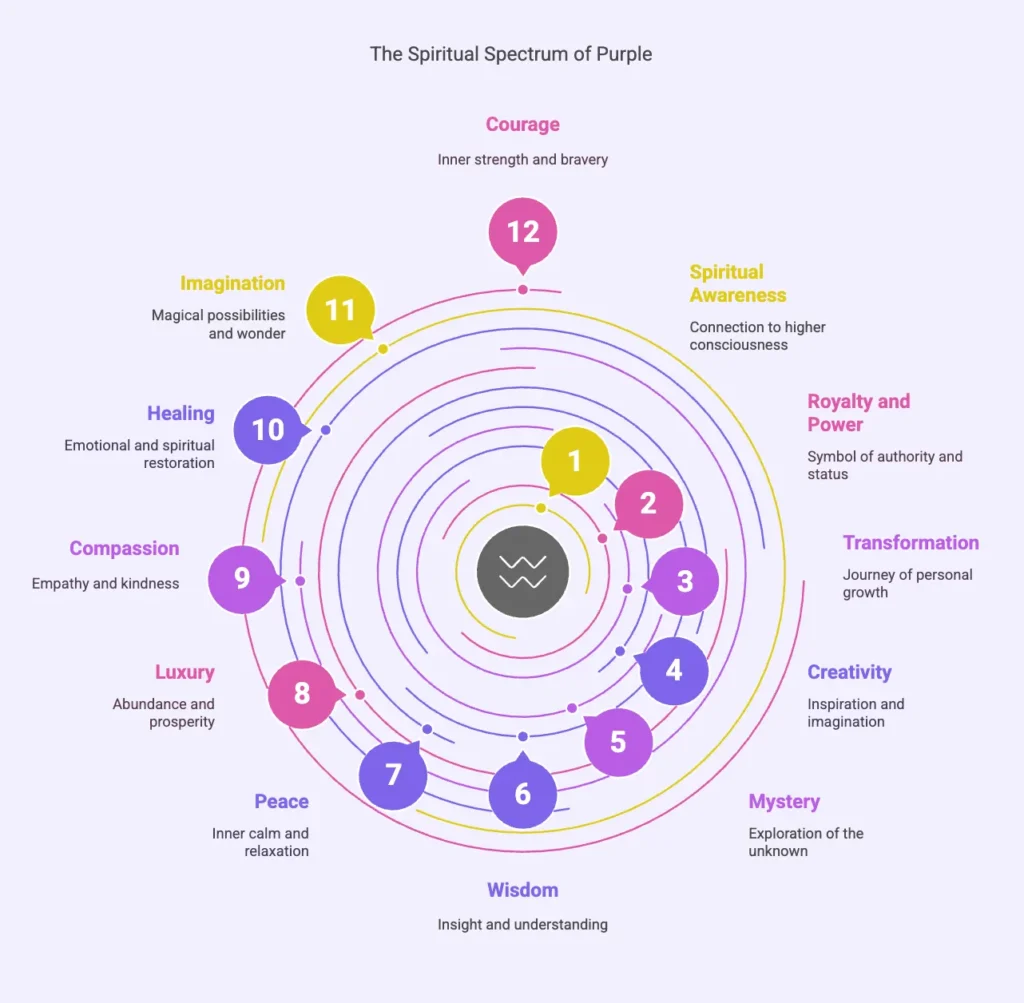Spiritual Meanings of Color Purple, Symbolism & Psychology

The color purple has long been associated with spirituality, mystery, and inner peace. From ancient traditions to modern psychology, it symbolizes wisdom, creativity, and transformation. But what does purple mean on a deeper, spiritual level?
In this guide, we’ll explore 12 spiritual meanings of the color purple, its symbolism, and its psychological impact. Whether you’re drawn to purple or simply curious, uncover how this powerful color influences the mind, soul, and emotions.
What Is the Color Purple?

The color purple is often associated with a blend of red’s fiery intensity and blue’s calming tranquility. This unique combination gives purple a feeling of balance, making it both mysterious and captivating. Purple exists in many shades, from deep, rich plum to soft, pastel lavender, each evoking different emotions and ideas.
Purple has long been admired for its rarity in nature. Before modern dyes were invented, it was incredibly hard to produce, which made it valuable. Because of this, purple became linked to luxury and exclusivity. Today, it remains a color that turns heads, invokes curiosity, and stands out in every palette.
On a visual level, purple combines the high-energy wavelengths of red with the soothing effects of blue. This unique mix is thought to stimulate both creativity and inner peace. This balance between opposites makes purple a deeply meaningful and versatile color.
Psychological and Metaphysical Interpretations of Purple
Psychologically, purple is thought to spark imagination and creativity. It’s often used to encourage original thinking and problem-solving. Brands targeting artistic or spiritual audiences frequently use purple in their designs to signal inspiration and sophistication.
On a metaphysical level, purple is strongly connected to spiritual awareness and higher consciousness. It’s believed to help people feel more in tune with their inner selves and the universe. Many spiritual traditions view purple as a gateway to awakening and enlightenment.
Interestingly, purple can also create a sense of mystery. Its depth and richness give it a mystical quality, making it a color that invites deeper thought. This connection to both imagination and spirituality is why purple is often described as a “catalyst” for self-discovery.
12 Spiritual Meanings of the Color Purple

1. Spiritual Awareness and Higher Consciousness
The color purple is deeply associated with spiritual awareness and the pursuit of a higher state of consciousness. It is often connected to practices such as meditation, prayer, or other spiritual rituals that allow individuals to connect with the divine. Many believe that purple serves as a bridge between the physical and spiritual realms, guiding one toward enlightenment.
This color is commonly linked to the crown chakra, which represents our connection to universal energy and higher wisdom. When this chakra is in balance, it fosters spiritual growth and an understanding of life’s deeper purpose. Purple reminds us to seek inner peace and align with a sense of divinity in our daily lives.
For those on a spiritual journey, purple serves as a beacon of transformation and growth. It urges individuals to go beyond their material desires and focus on their inner world, inspiring self-discovery and a closer relationship with the universe.
2. Royalty and Symbol of Power
Throughout history, purple has stood as a symbol of royalty, power, and wealth, as it was once one of the rarest and most expensive colors to produce. Kings, queens, and emperors adorned themselves in purple garments to signify their authority and status. This historical association continues to influence how we perceive purple today.
The color symbolizes dignity and respect, reminding us of our inner strength and the ability to lead with confidence. When we embrace purple in our lives, it can inspire us to hold ourselves to higher standards and take pride in our accomplishments.
Purple also serves as a reminder of empowerment and self-worth. It encourages us to embrace our personal power, take charge of our lives, and act as leaders in our own unique ways.
3. Transformation and Personal Growth
Purple is deeply tied to the concept of transformation, symbolizing personal growth and the journey toward becoming the best version of ourselves. It represents the changes we undergo as we evolve mentally, emotionally, and spiritually.
This color encourages us to embrace change, even when it feels uncomfortable or uncertain. Transformation often leads to profound self-discovery, helping us shed old habits and beliefs that no longer serve us. Purple acts as a guide through this process, urging us to trust in the path ahead.
Whether it’s a spiritual awakening or simply shifting perspectives, purple represents the beauty in growth. It reminds us that every challenge we face is an opportunity to transform and thrive.
4. Creativity and Expanding Imagination
Purple is often associated with creativity and boundless imagination. It inspires unique thinking and encourages individuals to explore new ideas and perspectives. Artists, writers, and innovators frequently use purple as a tool to spark their creative energy.
This color serves as a reminder that creativity knows no limits. It encourages us to break free from conventional thinking and embrace our individuality. Purple urges us to dream big and dive into unexplored areas of thought and expression, sparking innovation and originality.
By surrounding ourselves with purple, we open ourselves up to a world of inspiration and creativity. It reminds us that our imaginations are limitless, allowing us to create and shape our realities in extraordinary ways.
5. Mystery and the Unknown Realms
Purple has a natural connection to the unknown, its dark and rich tones evoking a sense of mystery and wonder. It is often seen as a color tied to the cosmos, representing the vastness of space and the secrets of the universe.
This association with mystery makes purple a symbol of curiosity and exploration. It encourages us to question the world around us and seek answers that lie beneath the surface. The color invites us to step into the unknown with courage and an open mind.
As a spiritual symbol, purple reminds us of the enigmatic nature of life. It teaches us to embrace uncertainty and trust that some mysteries are meant to unfold in their own time.
6. Wisdom and Profound Insight
Purple is frequently linked to wisdom and deep insight. It symbolizes the ability to think critically and reflect on life’s experiences to gain clarity. Those drawn to purple often possess a natural inclination for seeking knowledge and understanding.
The color encourages a thoughtful and introspective approach to life. It reminds us to take the time to analyze situations carefully and act with intention. Purple fosters a sense of maturity and helps us navigate challenges with grace and intelligence.
By embracing purple, we align ourselves with a mindset of learning and growth. It inspires us to seek wisdom not just through knowledge but through empathy and understanding of the world around us.
7. Peace and Inner Calm
Lighter shades of purple, such as lavender, are closely associated with peace and relaxation. This color has a soothing quality that helps calm the mind and bring emotional balance, especially in times of stress or uncertainty.
Lavender hues remind us to slow down and focus on self-care. They encourage practices such as meditation, yoga, or simply taking quiet moments to reflect. Purple helps create a tranquil space where we can find clarity and recharge our energy.
For those seeking emotional balance, purple acts as a gentle reminder to prioritize inner peace. Its calming presence allows us to navigate life with a sense of serenity and stability.
8. Luxury and Sense of Abundance
The rarity and richness of purple have long associated it with luxury and abundance. Historically, the dye used to create purple was expensive and reserved for the elite, making purple synonymous with wealth and exclusivity.
Today, purple symbolizes prosperity and success, reminding us to celebrate our achievements. It inspires us to strive for abundance in all areas of life, whether financial, emotional, or personal.
Embracing purple can also encourage us to treat ourselves with care and indulgence. It reminds us of the value in rewarding ourselves and recognizing the richness in life’s experiences.
9. Compassion and Empathy for Others
Purple is often seen as a color of compassion, symbolizing kindness, understanding, and empathy. It encourages us to connect with others on a deeper level, fostering meaningful relationships built on trust and care.
By surrounding ourselves with purple, we’re reminded to practice patience and understanding, even in challenging situations. The color inspires acts of generosity and selflessness, helping us support those around us.
This association with compassion also connects purple to self-love. It encourages us to be gentle with ourselves, promoting emotional healing and personal growth.
10. Healing Energy and Emotional Restoration
Purple is believed to contain healing vibrations, particularly for emotional and spiritual wounds. It is often used in energy healing practices to restore balance and aid in emotional recovery.
The color can bring comfort during difficult times, offering a sense of hope and renewal. It reminds us that healing is a process and encourages us to be patient with ourselves as we work through challenges.
Purple also promotes spiritual healing, helping individuals reconnect with their inner peace. It serves as a tool to release negativity and embrace positivity.
11. Imagination and Magical Possibilities
Purple fuels the imagination and opens the door to magical possibilities. It reminds us of the wonder and mystery in the world, encouraging us to dream big and believe in the power of creativity.
As a color strongly tied to fantasy, purple invites us to explore realms beyond reality. It fosters a sense of playfulness and curiosity, inspiring us to embrace the magic in everyday life.
This connection to imagination makes purple a powerful symbol for dreamers and visionaries. It reminds us to hold onto our sense of wonder and see the extraordinary in the ordinary.
12. Courage and Inner Strength
Bold shades of purple symbolize courage and bravery, reminding us of the inner strength needed to face life’s challenges. It serves as a powerful motivator to persevere through difficult times and maintain resiliency.
Purple empowers us to embrace our fears and take decisive action. It encourages us to step out of our comfort zones and face obstacles with determination.
By aligning with purple, we’re reminded of our own resilience and ability to overcome adversity. It inspires confidence and a belief in our capacity to rise above challenges.
Cultural Spiritual Meanings of Purple
Purple’s spiritual meaning varies across cultures but often contains similar themes. For example, in Japan, purple is a symbol of nobility and bravery. It is deeply respected and connected to virtue.
In Western cultures, purple is often linked to spirituality and royalty. Churches and religious ceremonies frequently incorporate purple to represent divine power.
For ancient Egyptian civilizations, purple represented sacred rite and ceremony. It carried a spiritual significance for guiding souls toward eternity.
Historical Usage of the Color Purple
Historically, purple has always been associated with wealth and status. The famous Tyrian purple dye, made from sea snails, was so expensive that it was reserved for emperors and royalty. For centuries, wearing purple was considered a privilege.
Purple also became a symbol of devotion and piety in religious ceremonies. It has been worn by bishops, saints, and clergy, symbolizing a connection to the divine.
Spiritual Symbolism of Different Shades of Purple
Light Purple or Lavender
Lavender is deeply connected to tranquility and inner peace. This soft shade of purple is often linked to moments of calm and relaxation, offering a sense of serenity even in stressful situations. It is frequently associated with meditative practices that focus on achieving mental clarity and emotional balance.
Light purple is also seen as a symbol of emotional healing. Its gentle hue is believed to soothe the mind and heart, helping individuals process difficult feelings in a nurturing way. Lavender encourages introspection, allowing people to confront their emotions without judgment or fear.
In spiritual symbolism, lavender represents a bridge between the physical and spiritual selves. It serves as a reminder to slow down and connect with the present moment. People often use this shade in healing practices, rituals, and spaces dedicated to rest and recovery.
Medium Purple or Violet
Violet shades are powerful symbols of spiritual awakening and transformation. They are often linked to the journey of discovering one’s higher purpose, urging individuals to embrace personal growth and evolve spiritually. This shade inspires reflection and helps people connect with the divine aspects of their lives.
Medium purple is also associated with creativity and imagination. It encourages people to think beyond the ordinary, unlocking new ideas and perspectives. For many, violet represents a push toward innovation and the pursuit of dreams, making it a perfect symbol for those seeking inspiration.
This shade carries an air of balance, blending the calmness of blue and the energy of red. It reminds individuals of the importance of harmony between different aspects of life. Violet is often used in spiritual practices as a tool for finding inner alignment and achieving a deeper understanding of the self.
Deep Purple or Plum
Deep shades of purple, like plum, are often tied to luxury and sophistication. They evoke an air of mystery and introspection, encouraging people to explore the depths of their own consciousness. Plum is a shade that invites individuals to embrace complexity and seek wisdom in the unknown.
Dark purple is also a symbol of emotional maturity. It represents the ability to navigate life’s challenges with grace and poise, reflecting a deep understanding of one’s own emotions. Many see this shade as an emblem of personal refinement and inner strength.
In spiritual contexts, plum is often linked to advanced stages of spiritual exploration. It encourages those on their journey to delve deeper, uncovering hidden truths and expanding their awareness. This rich color symbolizes the depth and richness of the spiritual experience.
Biblical Symbolism of Purple in Holy Texts
In the Bible, purple is frequently associated with royalty and divine authority. This color was historically used by kings and rulers to signify their status and power, emphasizing its connection to leadership and respect. It symbolizes the ultimate authority of God and His royal sovereignty over creation.
Purple also carries a sacred meaning in religious texts, often representing God’s grace and holiness. The Bible describes purple fabric being used in the construction of the temple’s veil, a symbol of the separation between the divine and humanity. This color highlights the sacredness and reverence of spiritual spaces.
Additionally, purple appears in many biblical stories as a sign of spiritual power. It often signals moments where divine will is at work, encouraging believers to trust in God’s plan. Its presence reminds individuals of their connection to the divine and their role in carrying out His purpose.
Purple as a Representation of the Crown Chakra Energy
Purple is widely recognized as the color of the crown chakra, located at the top of the head. This chakra is believed to be the center of spiritual connection, linking individuals to universal energy and higher consciousness. It serves as the gateway to enlightenment and profound understanding.
The crown chakra is also seen as a source of spiritual harmony. Activating this chakra helps individuals find balance between their physical and spiritual selves, fostering a sense of inner peace. It is considered essential for those seeking to transcend worldly concerns and achieve deeper self-awareness.
Meditation is commonly recommended for activating the crown chakra. Practices that incorporate purple imagery or crystals are thought to amplify its energy, making it easier to connect with higher realms. This chakra is a vital part of spiritual growth and achieving a state of enlightenment.
Spiritual Meaning of Seeing Purple in Dreams
Seeing the color purple in dreams is often interpreted as a sign of spiritual growth. It suggests that the dreamer is embarking on a journey of self-discovery, uncovering hidden truths and embracing their inner potential. Purple dreams can be a call to explore deeper aspects of one’s identity.
These dreams may also symbolize emotional healing and renewal. The appearance of purple can indicate that the dreamer is processing unresolved emotions, moving towards a place of balance and wholeness. It reflects the mind’s effort to release negativity and restore inner peace.
Additionally, purple in dreams is often linked to creativity and imagination. It may signal that the dreamer is on the verge of unlocking new talents or pursuing unrealized goals. Purple encourages exploration of ideas, reminding individuals of their ability to create and innovate.
Final Thoughts
Purple’s rich and layered meanings make it a color like no other. It inspires creativity, symbolizes spiritual awareness, and carries an air of mystery. Its uses across history, cultures, and spiritual practices only add to its profound significance.
By understanding the symbolism of purple, we can see why it continues to captivate both the mind and soul. This color invites reflection, imagination, and connection to something greater than ourselves.
You Might Also Like
1) 10 Spiritual Meanings of Purple Sky & Symbolism
2) Spiritual Meanings of the Color Indigo and Symbolism
3) Spiritual Meanings of Color Black, Symbolism & Psychology
4) Spiritual Meanings of the Color Brown, Symbolism & Psychology
5) 10 Spiritual Meanings of Silver Color: Symbolism & Psychology












